平成29年04月12日 水曜日号
“夜桜ひらり 平成18年”
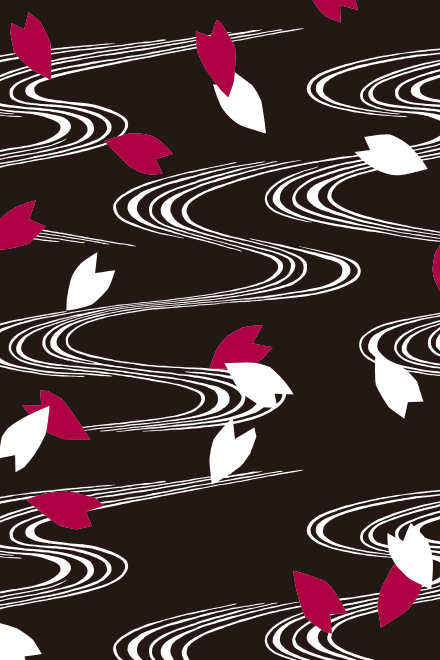
桜は三分咲き、五分咲き、満開とどの瞬間も美しい。
しかしそれにもまして魅力的なのは散っていくとき。
いさぎよく散る姿にもののあわれを感じ、
自分の人生を重ね合わせる。
夜桜がひらひらと舞い散る姿には
妖艶さも加わり一段と美しい。
(脇阪 克二)
"Sakura petals dance in the night"(2006,by Katsuji Wakisaka)
The lovely, amorous cherry blossom lady,
Beautiful in youth, and comely at all periods of life.
She burst into bloom, come into full blossom, and gracefully fall in her most fascinating time.
I always associate her falling with my life.
Sakura petals flutter and hover,
Ravishingly dancing in the night.
| English translation by LI XIAO XIAO |
"Cerisiers nocturnes"(2006, par Katsuji Wakisaka)
Qu'elles soient fleuries partiellement, à moitié ou totalement,
les fleurs de cerisiers sont splendides.
Mais le plus beau spectable reste quand leurs pétales tombent.
À leur vue, une compassion gracieuse nous envahit,
se superposant à nos propres vies.
Il y a quelque chose d’ensorcelant dans ces cerisiers nocturnes
qui se répandent en dansant, les rendant encore plus magnifiques.
| Traduction française par Jean-Baptiste Fauvel Matsumoto |
"夜櫻輕舞"(2006, 胁阪 克二)
櫻花開三分時美,半開也美,盛放時更甚。
但這些都美不過它凋謝的瞬間。
櫻花輕盈飄零的姿態讓我聯想到自己的人生。
夜櫻飛舞,舞姿绰约,香消玉陨百媚生。
| 中译 : 李 瀟瀟 |
平成29年04月08日 土曜日号
“すずしろ草 平成16年”
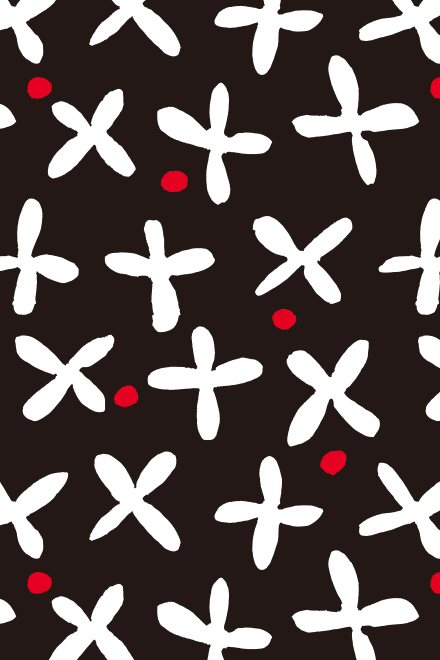
細い体つきだが茎をせいいっぱい伸ばして
真白な四枚の花びらをつけるすずしろ草。
ダイコンの花に似た可憐な花だが
厳しい傾斜地や崖などにも生育するたくましい花。
負けずにがんばろうと思わせてくれる。
(脇阪 克二)
"Small white flowers"(2004,by Katsuji Wakisaka)
These small white flower has slender figure but do all in its strength to grow.
They are with four pedals and resembling Japanese radish flowers in appearance.
Our small fighters are able to live in harsh environments,
Such as hillsides or cliffs.
They motivate me to hang in whenever I come across difficulties.
| English translation by LI XIAO XIAO |
"Arabis flagellosa"(2004, par Katsuji Wakisaka)
Cette fleur a un petit corps mais elle s'efforce de faire
pousser son pédoncule et ses fleurs blanches à quatre pédales.
C'est une fleur magnifique, ressemblant à celle du radis japonais,
et robuste, pouvant vivre dans des environnements difficiles
comme les bord de collines ou les falaises.
Tenez bon sans jamais abandonner, nous rappelle t-elle.
| Traduction française par Jean-Baptiste Fauvel Matsumoto |
"蘿蔔草"(2004, 胁阪 克二)
瘦瘦小小的蘿蔔草,
展開純白的四瓣花瓣,奮力生長。
十字花生命力頑強,在懸崖峭壁也能開出可愛的小花。
蘿蔔草的身影激勵我們堅持不放棄。
| 中译 : 李 瀟瀟 |
→こちらのテキスタイルデザイン商品
(Textile products with this pattern)
平成29年04月05日 水曜日号
“春風 平成23年”
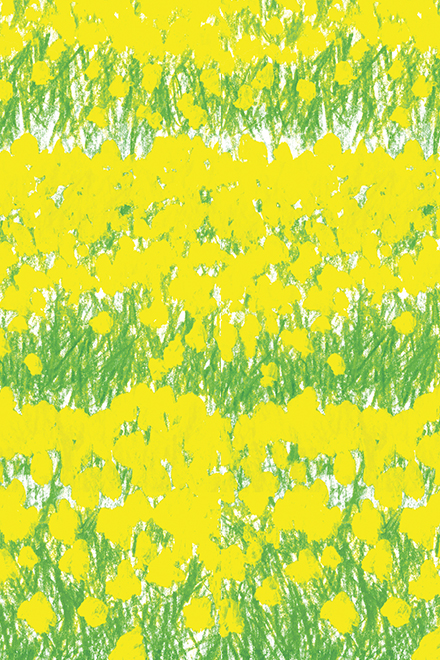
畑の間に点々と菜の花畑の黄色が
あるのは、まさに春の彩りといえる。
菜の花や 月は東に 日は西に
という蕪村の句は、のどかな春の
幸せな気持を感じさせてくれる。
(脇阪 克二)
"Spring breeze"(2011,by Katsuji Wakisaka)
The yellow of rape blossoms dotting in the field,
Describing a landscape of colorful spring.
This sight reminds me a haiku poem by Yosa Buson:
“Rape-flower fields / rising moon in the east / sinking sun in the west”
The calm and gentle spring brings us feelings of happiness.
| English translation by LI XIAO XIAO |
"Brise printanière"(2011, par Katsuji Wakisaka)
Le jaune des parterres de colza parsemant les champs est une preuve supplémentaire du printemps, peut-on dire.
“Fleurs de colza, Lune d’Est, Soleil d’Ouest”
Ce poème de Buson nous rappelle le bonheur calme et doux que nous apporte le printemps.
| Traduction française par Jean-Baptiste Fauvel Matsumoto |
"春風"(2011, 胁阪 克二)
春日田間的青綠中,
閃著油菜花的點點金黃。
這片景象讓我聯想到与謝蕪村的一首俳句:
『春至鄉村煙霧中,
一片金黃油菜花,
朦日西下朦月出。』
春的色彩吹來一陣拂面的暖意。
| 中译 : 李 瀟瀟 |
→こちらのテキスタイルデザイン商品
(Textile products with this pattern)
平成29年03月25日 土曜日号
“カタカナ 平成28年”

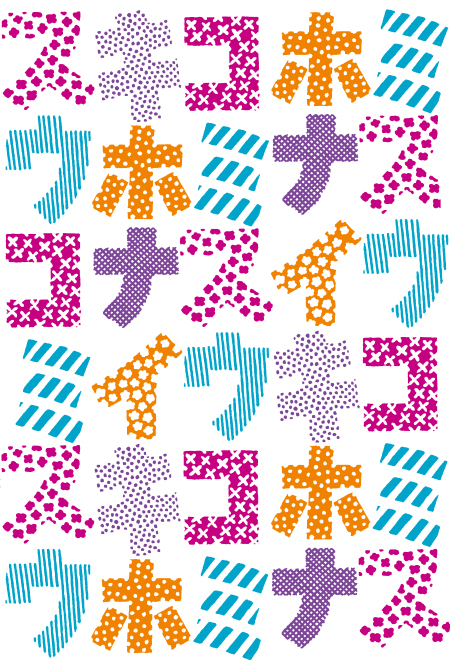
日本人は 漢字から ひらがな、
カタカナを創り出してきた。
ひらがなは それ自体で
美的に使われる様になった。
一方 カタカナは漢字を補足する
ことなど 記号的性格が強い。
しかし アルファベットの様に
直線と曲線で構成され
ポップでかわいい感じがする。
(脇阪 克二)
"Katakana"(2016,by Katsuji Wakisaka)
Japanese produced hinagara and katakana based on the Kanji.
While hinagara has a beautiful calligraphy style,
Katakana has a strong symbolic character.
However, resembling to the English alphabet,
Katakana consists of straight lines and curves,
Showing its pop and delightfully cute appearance
| English translation by LI XIAO XIAO |
"Katakana"(2016, par Katsuji Wakisaka)
Les japonais ont élaboré les katakana
À partir des hiragana, dérivés des kanji.
Les hiragana sont aujourd’hui utilisés
Comme tel, de manière esthétique.
D’un autre côté, les katakana, qui
Complémentaire aux nombreux kanji
Ont un caractère symbolique fort.
Cependant, à l’image des lettres de l’alphabet,
Ils sont faits de lignes droites et courbes,
Leur conférant un esprit pop très mignon.
| Traduction française par Jean-Baptiste Fauvel Matsumoto |
"片假名"(2016, 胁阪 克二)
日本人從漢字演化創造了平假名和片假名。
平假名來源于草書,流暢而美,
相比之下片假名更側重記號性。
片假名和英文字母ABCD一樣,
由直線和曲線組合而成,
雖然有棱有角,但也活潑可愛。
| 中译 : 李 瀟瀟 |
→こちらのテキスタイルデザイン商品
(Textile products with this pattern)
平成29年03月22日 水曜日号
“ほのぼの 平成20年”
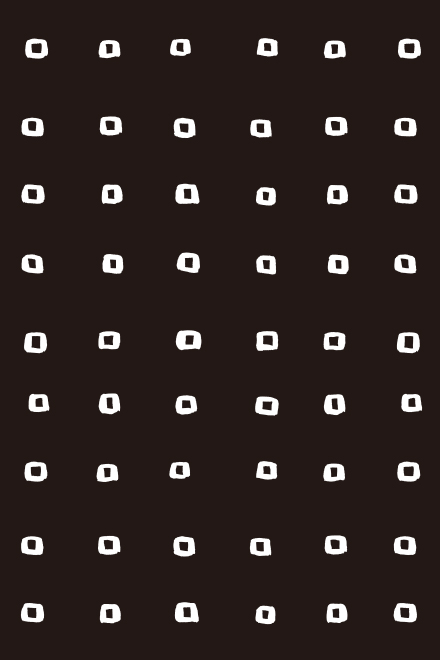
筆にたっぷり絵の具をつけてやわらかい気持ちで四角を描く。
肩の力を抜いて、でも気持ちは集中してゆっくり描く。
ひとつ描いて空間をとって又ひとつ描く。
並んでいる様に描いていても少しずつずれてくる。
ほのぼのしていて面白い。
(脇阪 克二)
"Honobono / Heartwarming"(2008,by Katsuji Wakisaka)
With a brush imbibed with paint, I delicately drew a square.
Relaxed but concentrated,
I finished it leisurely, leave a space, and drew another one.
These little squares tilted slightly even though I attempt to align them.
Simple and fascinating, with a mild warmth.
| English translation by LI XIAO XIAO |
"Apaisé"(2008, par Katsuji Wakisaka)
Avec un pinceau imbibé de peinture, je dessine délicatement un carré.
Relaxé mais concentré, je dessine sereinement.
Une fois fini, je laisse un espace et en réalise un autre.
Même si j'ai essayé de les aligner, ils sont légèrement excentrés.
Simple et fascinant.
| Traduction française par Jean-Baptiste Fauvel Matsumoto |
"暖暖"(2008, 胁阪 克二)
我握起沾滿顏料的畫筆,
手臂放鬆,精神集中,慢慢地輕輕地畫一個小四方形。
畫完一個,隔空再畫一個。
我試圖將這些小四方形整齊地排列,
畫著畫著卻自然地偏離。
完成的這幅紋樣意外地有趣,溫暖而動人。
| 中译 : 李 瀟瀟 |
→こちらのテキスタイルデザイン商品
(Textile products with this pattern)
平成29年03月18日 土曜日号
“離宮 平成元年”
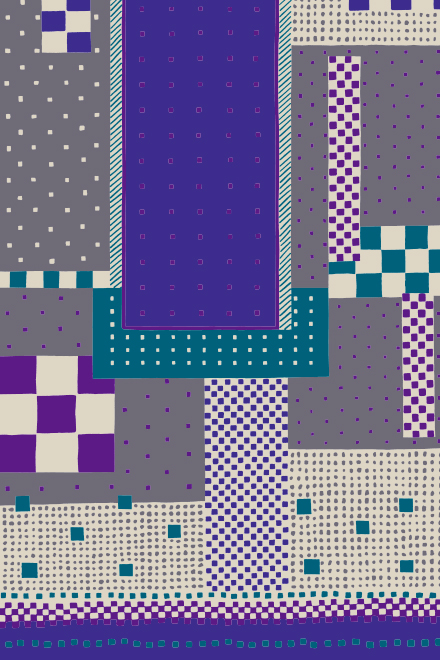
天皇や貴族のために
建てられたものだが
別荘として使われていた。
皇居とか宮殿のような
格式の高さはないかもしれないが
隅々まで個人的な趣味で
作り込まれている。
今の時代にはとても作れない。
(脇阪 克二)
"Rikyū / Imperial villa"(1989,by Katsuji Wakisaka)
Rikyū was built for the emperor and the nobilities as a villa.
Maybe it doesn't have the grandeur of the palace,
But there is an individual beauty,
Though which you can know about the architect who built them.
For this, hardly did I think it possible to build rikyū in the modern age.
| English translation by LI XIAO XIAO |
"La Villa Impériale"(1989, par Katsuji Wakisaka)
Édifiée pour l'empereur et la noblesse,
La villa servait de résidence secondaire.
Elle ne possède pas la grandeur du palais
impérial ou des palais et châteaux européens.
Cependant, elle est construite entièrement
en fonction de goûts personnels.
Impossible à produire de nos jours…
| Traduction française par Jean-Baptiste Fauvel Matsumoto |
"離宮"(1989, 脇阪 克二)
離宮是爲日本天皇或貴族所建的別墅。
雖然並不像皇居或宮殿一般高貴氣派,
但它的設計細節融入了很多獨特的個人風格。
這樣的建築是當今時代難以創造的。
| 中譯 : 李 瀟瀟 |
→こちらのテキスタイルデザイン商品
(Textile products with this pattern)
平成29年03月16日 木曜日号
“植物園 平成22年”
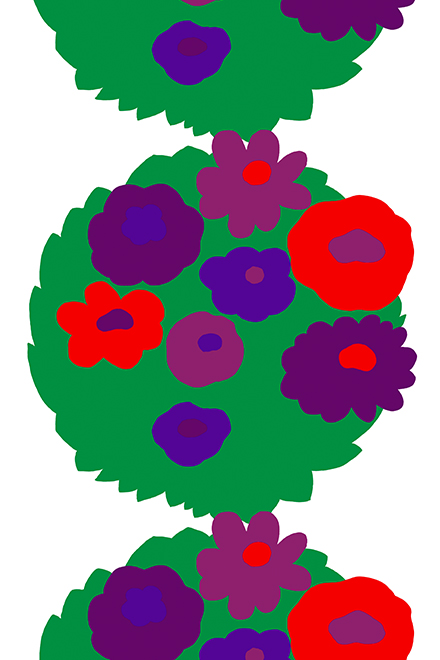
緑がいっぱいの植物園。
目に入ってくるものは
心地よい緑、緑、緑。
その中に色鮮かな花が咲いている。
植物園は花と緑の国。
(脇阪 克二)
"Botanical garden"(2010,by Katsuji Wakisaka)
Botanical garden,
Filled with refreshing green,
Embellished with brightly colored flowers.
Botanical garden,
A valley of flowers and natural green.
| English translation by LI XIAO XIAO |
"Jardin botanique"(2010, par Katsuji Wakisaka)
Un jardin botanique rempli de vert.
Tout ce qui rentre dans notre champ de vision,
C’est de la verdure et encore de la verdure.
A l’intérieur, une fleur éclatante s’épanouie.
Le jardin botanique est le royaume des fleurs et de la verdure.
| Traduction française par Jean-Baptiste Fauvel Matsumoto |
"植物園"(2010, 胁阪 克二)
植物園充滿了綠色。
滿眼都是舒心的綠,綠,綠。
其中開一些鮮豔的花。
植物園就是一處花和綠的國度。
| 中译 : 李 瀟瀟 |
→こちらのテキスタイルデザイン商品
(Textile products with this pattern)
平成29年03月11日 土曜日号
“菜の花 平成26年”
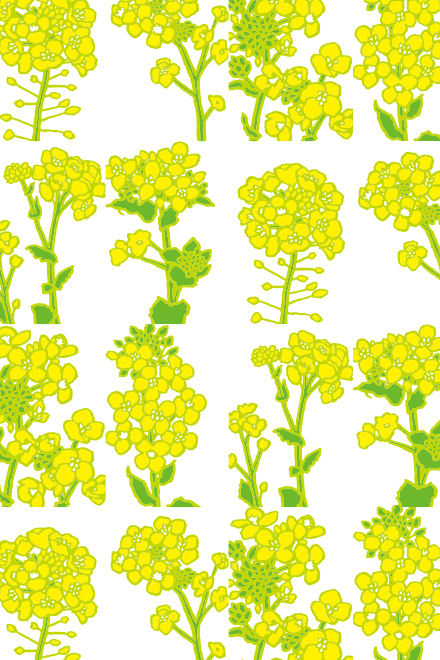
菜とは食用の意味で菜の花とは食用の花。
まだ寒い時期から黄色い花を咲かせた
菜の花が野菜売場に並ぶ。
その明るい黄色と少し苦味のある味が
食卓に春を運んでくる。
(脇阪 克二)
"Nanohana"(2014,by Katsuji Wakisaka)
"Na" of nanohana in Japanese implies "edible"
and "nanohana" means briefly "edible flower".
From the season it is still cold
nanohana (canola flower) with blooming little yellow flowers,
show up in vegetable stores.
The brightness of its yellow and little bit bitter taste
bring spring to our dinning table.
| English translation by LI XIAO XIAO |
"Nanohana"(2014, par Katsuji Wakisaka)
“Na” signifie comestible et “Hana” fleur, ce qui peut être traduit par “fleur comestible”. En cette saison encore froide, les nanohana décorent les fleuristes de leur petite fleur jaune. La clarté de ses couleurs et son goût un peu amer Amène sur nos tables le printemps.
| Traduction française par Jean-Baptiste Fauvel Matsumoto |
"菜花"(2014, 胁阪 克二)
“菜”有可供食用的意思,
菜花指可食用的花。
菜花在初春尚寒的時節開出明燦燦的黃花,
擺在蔬菜市場也甚爲亮眼。
那一抹明亮的金黃和微苦的味道,
宣示著餐桌上春的到來。
| 中译 : 李 瀟瀟 |
→こちらのテキスタイルデザイン商品
(Textile products with this pattern)
平成29年03月08日 水曜日号
“春一番 平成21年”
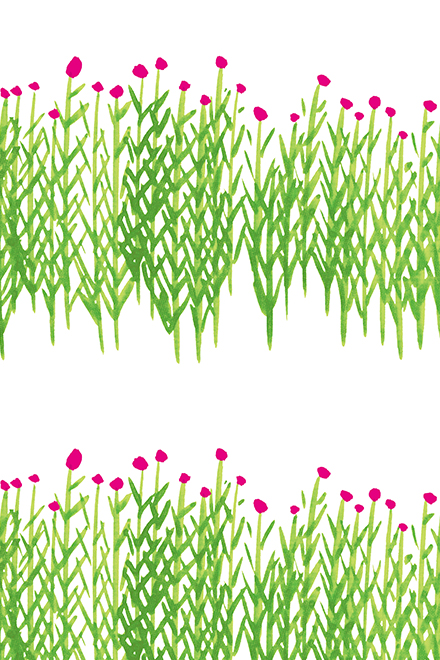
まだ少し肌寒い春の風にさそわれて外に出ると、
暖かな日差しの中に小さな赤い花がいっぱい咲いている。
点々と並んで背くらべをするように、
競い合って大きくなろうとしている。
野の花のたくましさ可憐さに、
生きていることはこういうことだと教えられる。
(脇阪 克二)
"Spring here!"(2009,by Katsuji Wakisaka)
I took a walk in early spring,
The cold breeze blows gently,
A number of little red flowers blossom in the bright sunshine,
Straightening their back to see who is the tallest.
Wild flowers,
Thriving on competition,
Grow up healthy and strong,
Teaching us the meaning of life.
| English translation by LI XIAO XIAO |
"Voilà le printemps!"(2009, par Katsuji Wakisaka)
Invité par le vent printanier encore frais,
je sors faire un tour et suis accueilli par
une multitude de petites fleurs rouges épanouies.
Comme si elles comparaient leur taille,
elles entrent en compétition et s'efforcent de se grandir.
À l'image des fleurs si frêles et si fortes,
Elles nous enseignent le sens de la vie.
| Traduction française par Jean-Baptiste Fauvel Matsumoto |
"初春的風"(2009, 胁阪 克二)
初春散步,風微涼。
一叢小小的紅色花朵星星點點地開在陽光下。
並排著比這高矮,爭先恐後地生長。
小野花旺盛而可愛,
教會我們生命的意義。
| 中译 : 李 瀟瀟 |
→こちらのテキスタイルデザイン商品
(Textile products with this pattern)
平成29年03月04日 土曜日号
“染付け 平成23年”
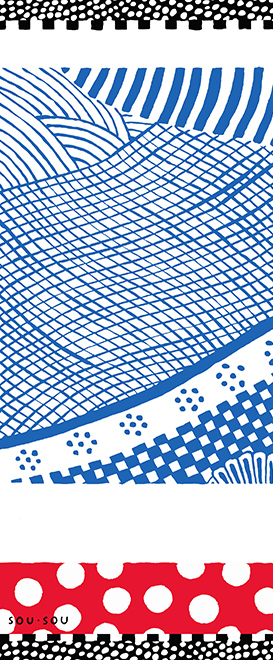
素焼の磁器に呉須という顔料で絵付け。
その上に釉薬をかけて焼き上げる。
白く艶のある地に濃淡のある青で
味わいのある模様が絵描かれている。
染付けは日本の食器の
代表的なもののひとつだ。
(脇阪 克二)
"Sometsuke / Blue glaze"(2011,by Katsuji Wakisaka)
Sometsuke, or blue and white pottery is white porcelain painted by gosu or zaffer, and decorated with blue under the glaze.
Classically beautiful patterns are painted in a range of tones of blue on bright white base.
Sometsuke is one of the representative tableware of Japan.
| English translation by LI XIAO XIAO |
"Sometsuke / Teinture"(2011, par Katsuji Wakisaka)
La technique Sometsuke est le procédé de teinter
De la porcelaine blanche avec des pigments appelés gosu.
Le tout est ensuite glacé et cuit.
De manière classique, de magnifiques motifs sont peints
dans différents tons de bleu sur une base blanche.
Le Sometsuke est une des vaisselles représentatives du Japon.
| Traduction française par Jean-Baptiste Fauvel Matsumoto |
"染付"(2011, 胁阪 克二)
染付,是日本陶瓷界對青花瓷器的稱呼。
用青料進行色繪曰“染”;付,即紋飾。
染付即在晶瑩潔白的坯體上,
用濃淡層次分明的青料色繪紋飾。
染付磁器是日本的代表性食器之一。
| 中译 : 李 瀟瀟 |
→こちらのテキスタイルデザイン商品
(Textile products with this pattern)
平成29年03月01日 水曜日号
“おはじき大 平成18年”
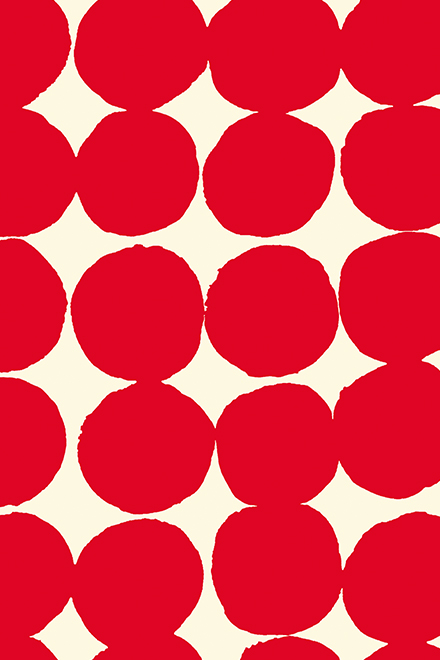
おはじきはかわいいデザインですが、
大柄のものはとても大らかで
ゆったりしている。
ホッとする暖かい雰囲気が出てきたことは不思議に思う。
(脇阪 克二)
"Large marbles"(2004,by Katsuji Wakisaka)
Ohajiki, Flattened marbles,
Small and cute.
I draw some large marbles,
Finding that they are having surprisingly different mood,
Gentle, warm and broad-minded.
| English translation by LI XIAO XIAO |
"Jeu de puce"(2004, par Katsuji Wakisaka)
Les petits marbres plats ont de bien jolis designs mais
À grande échelle, ils sont imposants et tranquilles.
Cette air doux et calme en ressortant est étrange.
| Traduction française par Jean-Baptiste Fauvel Matsumoto |
"彈珠"(2004, 胁阪 克二)
彈珠原本小巧可愛,
而放大版的彈珠紋樣,
顯得悠悠然,暖洋洋的,
真是不可思議。
| 中译 : 李 瀟瀟 |
→こちらのテキスタイルデザイン商品
(Textile products with this pattern)
平成29年02月25日 土曜日号
“律 平成28年”

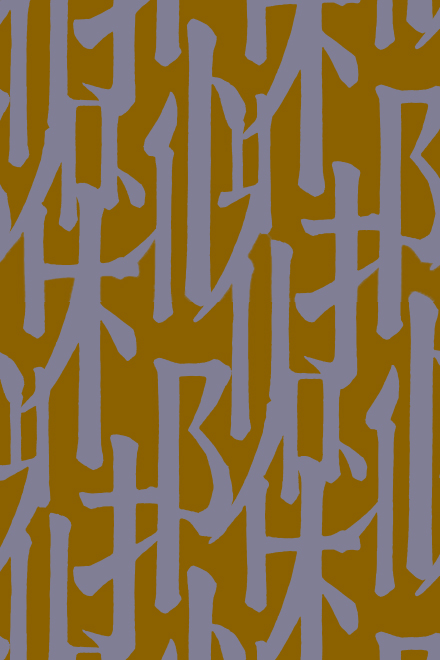
漢字は偏(へん)、旁(つくり)、冠(かんむり)など
いくつかの部分で構成されている。
偏だけを使って 縞模様のような
柄をつくる。
漢字独特の強弱やリズムが
ある心地良さと 施律をかなでてくる。
規律の中の美しさとも言える。
人も自分自身を律して生きると
美しい。
(脇阪 克二)
"Ritsu / Rhythm"(2016,by Katsuji Wakisaka)
Kanji, or Chinese character, are made of hundreds of radicals.
I picked a radical to made this stripe-looking textile design.
Kanji has their unique rhythm, which makes me feel pleasant.
That’s the same as individual.
People who follow their own rhythm are outstandingly beautiful.
| English translation by LI XIAO XIAO |
"Ritsu / Rythme "(2016, par Katsuji Wakisaka)
Les Kanji, caractère d’origine chinoise, sont construits à partir de nombreuses clés. J'ai utilisé la clé hen 偏 afin de créer ce motif en forme de bandes. Il existe un rythme unique à chaque caractère, Une mélodie apaisante et réconfortante. Une sorte de beauté dans la discipline, pourrait-on dire. Les personnes qui suivent leur propre rythme sont également ravissantes.
| Traduction française par Jean-Baptiste Fauvel Matsumoto |
"律"(2016, 胁阪 克二)
漢字由偏旁,部首,字頭等部分構成,
我只取「偏旁」這個元素,
將其設計成條文花樣的3月織紋。
漢字有它獨特的強弱和律動,
規律中含有一種舒暢人心的韻律美。
人也是如此,
擁有自身獨特節奏律動的人很美。
| 中译 : 李 瀟瀟 |
→こちらのテキスタイルデザイン商品
(Textile products with this pattern)
平成29年02月18日 土曜日号
“きくまる 平成20年”
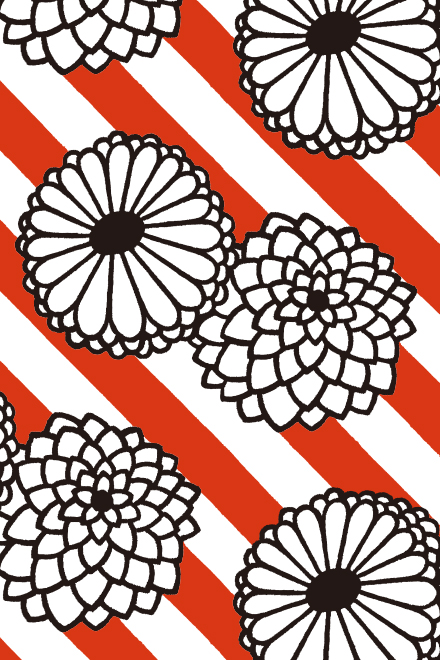
昔の着物の模様は、今の日本人の意識では
考えられないほど大胆なものが多い。
今よりずっと精神が自由でいきいきしていた。
そんな時代への憧れを菊と縞に託して。
(脇阪 克二)
"Kikumaru / Striped mums"(2013,by Katsuji Wakisaka)
According to modern Japanese aesthetics, some of ancient kimono patterns can be deemed bold.
They are daring, far beyond our imagination, showing the active and creative thought.
I long for the old-style and project that into the chrysanthemums and stripes of this textile.
| English translation by LI XIAO XIAO |
"Kikumaru"(2013, par Katsuji Wakisaka)
D'après l’esthétique moderne japonaise, certains ancient motifs de Kimono peuvent être considéré comme osé. Ils sont audacieux, plus que de raison, et représente des idées actives et créatives. J'ai transcrit mon attrait pour cette époque lointaine en incorporant des chrysanthèmes et des bandes à ce textile.
| Traduction française par Jean-Baptiste Fauvel Matsumoto |
"菊丸"(2013, 胁阪 克二)
按照現代日本人的審美標准,
舊時和服的花紋是大膽的。
那份明朗鮮活更能體現一種精神自由。
我把對古風的憧憬寄托在了這些菊花紋樣裏。
| 中译 : 李 瀟瀟 |
→こちらのテキスタイルデザイン商品
(Textile products with this pattern)
- コメント
-
あるブログで紹介されていた記事を読ませていただきました。
--------------------------------------------------—
「一日一信」は、17年間、欠かさず続けてきた習慣だ。
朝食後、机に向かい郵便はがきに一枚の絵を描く。
そして妻宛に投函する。 〜 季刊『銀花』第153号
--------------------------------------------------—
心に響きました。
ああ、なんて素敵なんだろう。
ただただそう思うと、何故か自分が奥様になったように錯覚して嬉しさいっぱいの気持ちになるのです。
昨年はじめてSOU・SOUさんを知り、それ以来脇坂さんのデザインされた手ぬぐい等も日々の生活に取り入れています。
これからも地方のこの場所で、脇坂さんのテキスタイルをSOU・SOUを愉しんでいけたら、と思っています。
金沢のS.K.様
僕はあたりまえに日常で使われるテキスタイルデザインを作りつづけたいと思っています。
末永く使ってやって下さい。
- 最近書いた記事
- 関連記事
-
平成29年02月15日 水曜日号
“金平糖 平成25年”
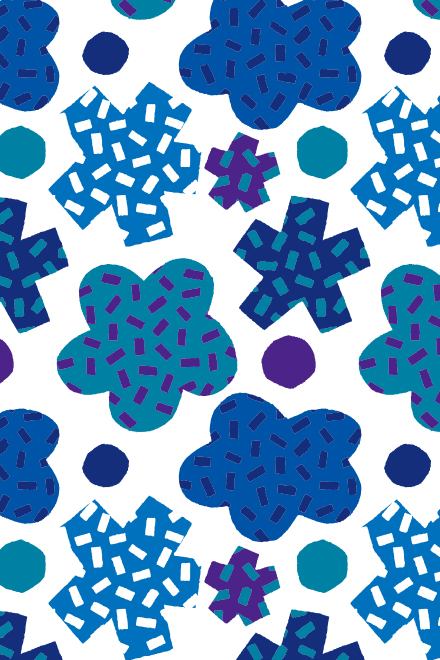
回転する円形の鉄の大鍋に砂糖と下味のついた水を入れ
温めながら根気よくかきまぜていくことで出来る金平糖。
作っていく段階で角(つの)のようなものがいくつも出来て
あの不思議な形になる。
舌に触れる感じとほのかな甘さがいい。
金平糖の語源はポルトガル語だそうだが
その言葉のひびきも魅力のひとつだと思う。
(脇阪 克二)
"Konpeitō / Confetti candy"(2013,by Katsuji Wakisaka)
Mix sugar with pre-seasoned water,
Heat it in a giant circular rotating tub,
Keep stirring constantly, the Konpeitō finally complete.
These tiny candies are shaped into miraculous stars during the process.
Their unique texture and soft sweet flavor are amazing.
"Konpeitō" comes from Portuguese word "Confeito" (a type of sugar candy),
The sound of the word was fascinating to me.
| English translation by LI XIAO XIAO |
"Konpeito / Etoile sucrée"(2013, par Katsuji Wakisaka)
Dans un chaudron rond en acier, ajoutez du sucre et de l’eau aromatisée.
Mélangez avec patience tout en chauffant le tout. Et la voilà: l’étoile sucrée.
A mesure de sa préparation, de petites cornes se forment tout autour
Et elle prend cette forme si particulière.
Cette douceur sucrée qui fond sur la langue est savoureuse.
L’origine du nom “Konpeito” est paraît-il portugaise.
Le nom du bonbon en lui-même est attrayant.
| Traduction française par Jean-Baptiste Fauvel Matsumoto |
"金平糖"(2013, 胁阪 克二)
金平糖的做法是在可旋轉的巨型炒鍋中加熱糖水,
並用鐵鏟不停地鏟動讓水分蒸發將糖分裹在芯料外而成。
外形似球形的珊瑚,小巧別致。
金平糖不僅有獨特的口感和淡淡的甜味,
它的名字是葡萄牙語"confeito"的音譯,
其音韻也是魅力獨具。
| 中译 : 李 瀟瀟 |
→こちらのテキスタイルデザイン商品
(Textile products with this pattern)
平成29年02月11日 土曜日号
“丸に小菊 平成23年”
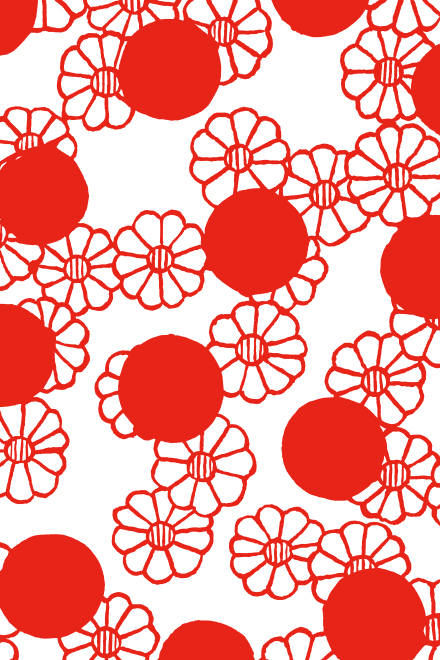
桜が春の花なら
菊は秋の花。
小菊は日々の暮らしの
あらゆる場面に登場する。
日本人が最も身近に
感じている花のひとつではないだろうか。
(脇阪 克二)
"Dots and chrysanthemum"(2011,by Katsuji Wakisaka)
If you say cherry blossom is the flower of spring,
Then chrysanthemum is the one of autumn.
Chrysanthemum is everywhere in our daily life.
I suppose it's one of the most familiar flowers in Japan.
| English translation by LI XIAO XIAO |
"Des chrysanthèmes ronds"(2011, par Katsuji Wakisaka)
Si les cerisiers sont les fleurs du printemps,
Les chrysanthèmes sont celles de l’automne.
Elles sont partout dans notre vie quotidienne.
Je suppose qu’il s’agit d’une des fleurs
les plus familières pour le peuple japonais.
| Traduction française par Jean-Baptiste Fauvel Matsumoto |
"圓與小菊"(2011, 脇阪 克二)
如果說春天的代表是櫻花,
那秋天則是菊花。
小菊常見於日常生活中的各種場景,
是日本人最熟悉的花卉之一。
| 中譯 : 李 瀟瀟 |
→こちらのテキスタイルデザイン商品
(Textile products with this pattern)
平成29年02月08日 水曜日号
“花椿 平成21年”
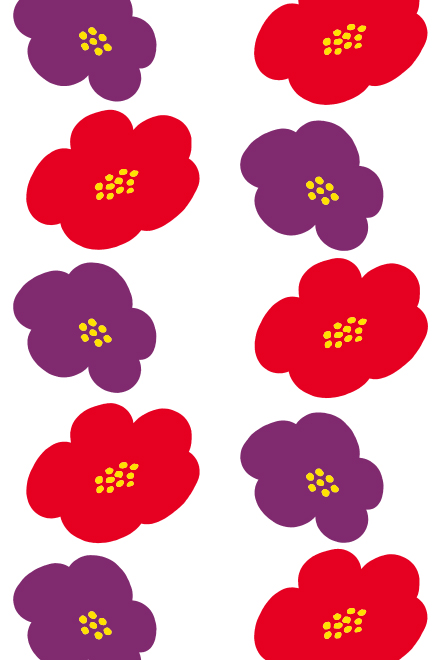
濃い緑の葉の中に鮮やかな赤い花が映える椿。
桜や山吹のように花びらだけを散らせることはなく
花全体が音を立てて地に落ちる。
その音がかえってまわりの静けさを際立たせてくる。
一面の苔の上に赤や白の椿が落ちている状景は
華やかで幽玄。情念の世界を垣間見せてくれる。
(脇阪 克二)
"Camellia flowers"(2009,by Katsuji Wakisaka)
Bright red flowers blooming on the green camellia tree.
Unlike cherry blossom or globeflowers that lose their petals and die,
Camellia falling off by the whole,
Plopping down with a beat,
And all the noise is silenced surround.
This textile represent camellia flowers shade in red or white,
Dropping down on a carpet of moss.
The subtle and profound view strike my eye.
| English translation by LI XIAO XIAO |
"Fleurs de camélia"(2009, par Katsuji Wakisaka)
De belles fleurs rouges vifs qui éclosent sur un fond de feuilles vertes de camélia.
A l’inverse des cerisiers ou des corètes du Japon, dont seuls les pétales tombent,
Les fleurs de camélias choient dans leur intégralité, émettant un son singulier.
Ce même son accentue le silence ambiant.
Notre textile représente des fleurs de camélias rouges et blanches, couchées sur
Un matelas de mousse, invitant nos yeux à un spectacle subtil et profond.
| Traduction française par Jean-Baptiste Fauvel Matsumoto |
"花椿"(2009, 脇阪 克二)
茶花透過濃密的綠葉,露出通紅的臉。
凋謝的時候,不似櫻花或是棣棠般花瓣一片片飄零,
而是整朵墜落,擲地有聲,襯托出山野的寂靜。
我以紅色和白色的茶花墜落的場景作畫,
幽玄華美的景象,讓人沉浸於幻想世界。
| 中譯 : 李 瀟瀟 |
→こちらのテキスタイルデザイン商品
(Textile products with this pattern)
平成29年02月05日 日曜日号
“雪うさぎ 平成22年”
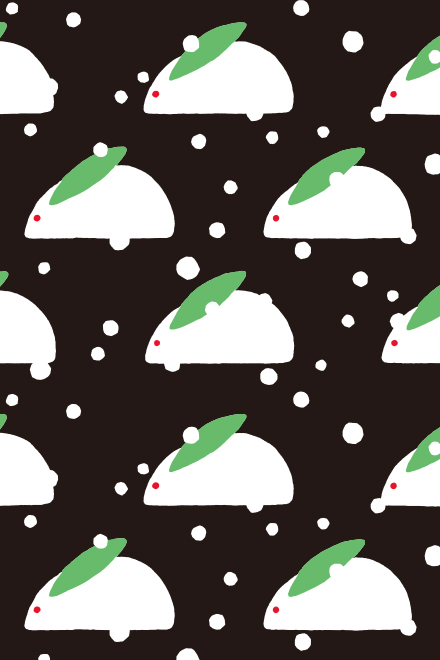
雪をかためてうさぎの形をつくり、南天の赤い実を目に、緑の葉を耳にして、子供達が遊んだ雪うさぎ。
降りしきる雪の中、何頭もの雪うさぎが並んで何かを待っている。それは暖かな春のおとずれだろうか。
(脇阪 克二)
"Snow rabbit"(2010,by Katsuji Wakisaka)
Pack the snow tightly and shape it into a rabbit.
Place two nandina berries to represent the red eyes,
Use green leaves to act as ears,
Here comes the snow rabbit!
One, two, three……Some snow rabbits are arranged in the snow,
Waiting for something.
For the next warm spring? I suppose so.
| English translation by LI XIAO XIAO |
"Lapin de neige"(2010, par Katsuji Wakisaka)
Empiler la neige en lui donnant la forme d’un lapin.
Placer deux fruits de Nandina pour les yeux,
Des feuilles vertes pour les oreilles,
Voilà le Lapin de Neige, avec les enfants jouent.
Sous la neige qui ne cesse de tomber, une multitude de
Lapins de Neige attend patiemment, les uns à côté des autres.
Attendent-ils la venue du doux printemps?
Que la Nouvelle Année du Lapin vous sourie!
| Traduction française par Jean-Baptiste Fauvel Matsumoto |
"雪兔"(2010, 胁阪 克二)
把雪捏成小團,用南天竹的紅果作眼睛,綠葉作兔耳,
這是日本的小朋友們常做的雪兔。
幾只雪兔排布在雪地裏,
等待。
或許是在等下一個暖春的來臨。
| 中译 : 李 瀟瀟 |
→こちらのテキスタイルデザイン商品
(Textile products with this pattern)
平成29年02月01日 水曜日号
“椿文 平成23年”
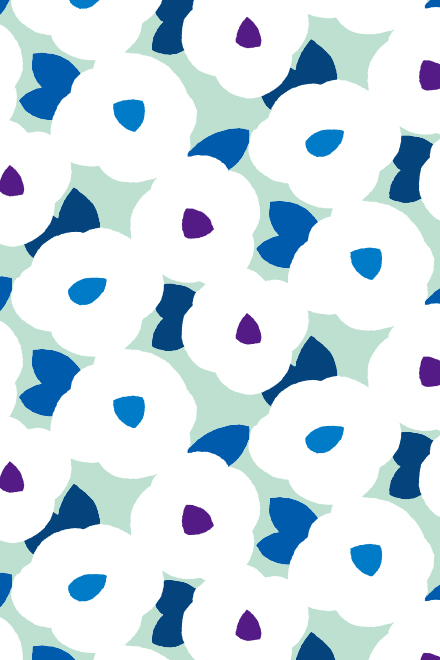
椿にはいろんな表情があるが
これはかわいい椿文様
ぽっちゃりした椿の花が
並んでいるのだが
おおらかで暖かい花に
包まれているようでしあわせな気持になれる
(脇阪 克二)
"Camellia"(2011,by Katsuji Wakisaka)
Lady Camellia, has many faces,
I drew some, chubby and lovely ones,
Standing there side by side.
Lady Camellia,
Cheerful and generous,
Warming our hearts and make us feel happy.
| English translation by LI XIAO XIAO |
"Sceau du camélia"(2011, par Katsuji Wakisaka)
Le camélia a de nombreux aspects.
Quel joli sceau en forme de camélia!
De grosses fleurs de camélia se succèdent généreusement,
Comme si nous étions entourés de ces fleurs chaleureuses
qui nous rendent si heureux.
| Traduction française par Jean-Baptiste Fauvel Matsumoto |
"椿文"(2011, 脇阪 克二)
椿花姿態萬千,
我描繪的是可愛版椿文。
將這些圓潤的花兒平鋪在畫布上,
仿佛環繞在溫暖柔和的花叢中,
心中漾起療愈的幸福感。
| 中譯 : 李 瀟瀟 |
→こちらのテキスタイルデザイン商品
(Textile products with this pattern)
平成29年01月28日 土曜日号
“清流に梅 平成23年”
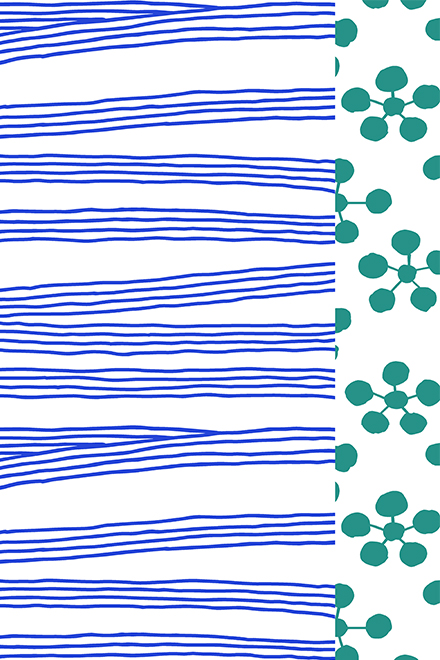
澄んだ水がいく筋も
流れ下っていく。
風は冷たいが、川のそばの
梅は真白い花を咲かせている。
見ていると心が澄み切って気持ちがいい。
(脇阪 克二)
"Blossoms and streams"(2011,,by Katsuji Wakisaka)
Clear streams flowing down.
Plum trees by the riverside blooms with pure white,
Regardless of the chilly wind.
Seeing this,
My mind becomes clear and pure.
| English translation by LI XIAO XIAO |
"Prunier dans un courant limpide"(2011,, par Katsuji Wakisaka)
Un courant limpide s'écoule paisiblement.
Les pruniers au bord de la rivière fleurissent d'un blanc pur,
s'inquiétant peu du vent froid. À la vue d'un tel spectacle,
mon âme devient claire et pure.
| Traduction française par Jean-Baptiste Fauvel Matsumoto |
"清流與梅"(2011,, 胁阪 克二)
淙淙流水,潺潺向下。
寒溪兩側有雪梅,
冰肌玉骨,傲寒獨放。
此景令我內心澄澈如洗。
| 中译 : 李 瀟瀟 |
→こちらのテキスタイルデザイン商品
(Textile products with this pattern)
平成29年01月25日 水曜日号
“はじまり 平成28年”

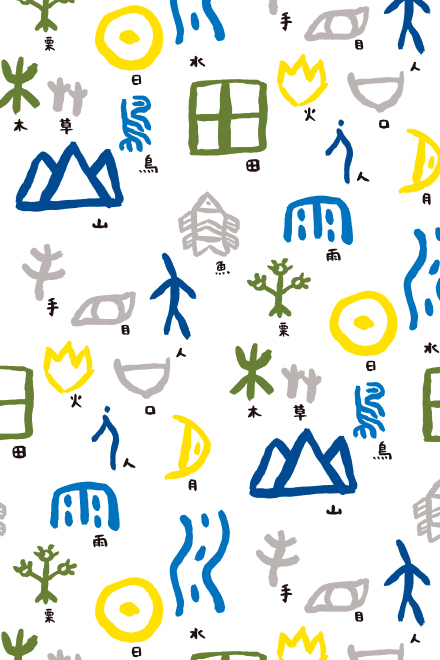
物事には はじまりがある
漢字は 物の形をまねて書くことから
はじまり 少しずつ進化して
現在の形になってきた
人も生まれて 人生がはじまり
成長していく
はじまりのころは
漢字も人も かわいいですね
(脇阪 克二)
"Beginning"(2016,by Katsuji Wakisaka)
Everything has a beginning.
Kanji (Chinese characters) is no exception.
The earliest kanji were just pictographs that kind of looked like something.
Then it developed, step by step, becoming what they are today.
So does man.
We were born to live, growing to complete individuals.
Things are fascinating at the very beginning,
Both for kanji and man.
| English translation by LI XIAO XIAO |
"Commencement"(2016, par Katsuji Wakisaka)
À chaque chose, son commencement.
L'écriture japonais a été créée
en représentant la forme des objets.
Au départ, elle a évolué petit à petit
Pour arriver à sa forme actuelle.
Les hommes naissent également,
Marquant le début de la vie,
Et grandissent d'année en année.
Cette étape de commencement est charmante,
Tant pour l'écriture que pour les hommes.
| Traduction française par Jean-Baptiste Fauvel Matsumoto |
"始"(2016, 胁阪 克二)
萬物皆有始。
漢字是從最初的象形符號,
一步步進化而來。
人也是如此。
出世,成長,體驗人生。
萬事萬物的初始,
總是充滿著吸引力。
| 中译 : 李 瀟瀟 |
→こちらのテキスタイルデザイン商品
(Textile products with this pattern)


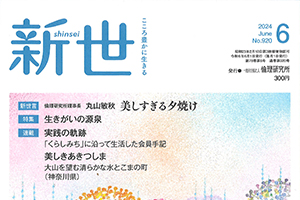

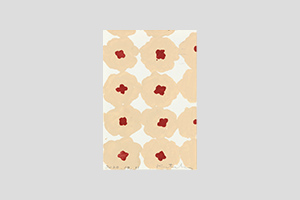
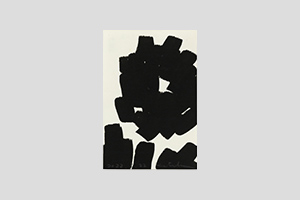
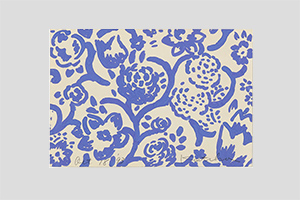
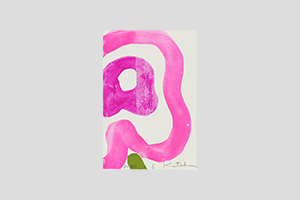

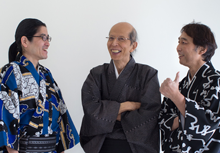

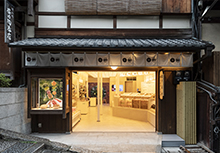

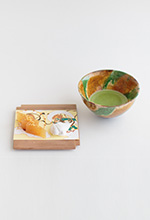
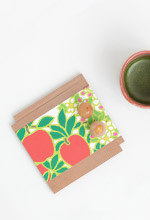










 お問い合わせ窓口
お問い合わせ窓口











いつも見せてもらってたのしんでいます。
これも高貴な色紫を使って丸と四角だけで表現してあり素晴らしいですね。
色の組み合わせ 柄の組み合わせが素晴らしいと思います。
島津様
何を以て美とするか、の最も簡素で究極なものがそこにありそうな気がしました。